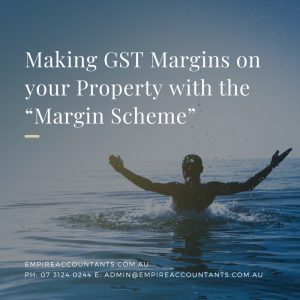Making GST Margins on your Property with the “Margin Scheme”
Posted 24 Jul '18
Posted 24 Jul '18
Generally GST doesn’t apply to the sale or purchase of a property which is used predominately for private accommodation. So in instances where you are selling your main residence or a rental property, you won’t lose 10% of your sales proceeds in tax. Winning!
But don’t be caught out, there can be situations where you will need to pay GST on the sale of your property. Basically, there is this wonderful grey area called a ‘profit making plan’, where if a transaction is entered into for the purposes of making a profit, then in effect you are carrying on an enterprise.
 “But let’s be honest, when we would ever really purchase something for the purposes of making a loss. I, for one, sure would like the
concept of profit ~ you know being an accountant an all”.
“But let’s be honest, when we would ever really purchase something for the purposes of making a loss. I, for one, sure would like the
concept of profit ~ you know being an accountant an all”.
Now if the sale price is under $75,000, then you can rest easy ~ maybe like 50 years ago. But in this day and age, chances are that GST will apply on this transaction.
Unfortunately, this is where a lot of your mum and dad property investors or property developers can be caught out. Because the moment you renovate, extend or sub-divide and build on your investment property for the intent to make a profit, the ATO will be licking their hands for a GST piece of the Pie.
But is there any way to reduce that portion the ATO takes away in GST?
This is where the GST Margin Scheme is your saving grace. In short, if you are eligible to apply the Margin Scheme, the GST is calculated on the ‘net profit’ instead of the sale price. To be eligible:
• The sale must be subject to GST (a taxable supply under S.9-5);
• The seller and buyer must agree in writing that the margin scheme is to be applied (normally drafted into the sale contract in the body or
as a special condition); and
• The seller must not have acquired the property and they claimed a GST credit (for example if you are purchasing vacant land).
This can be huge, and can be the difference between making an overall profit or a loss on a development project. To demonstrate let’s run your through a scenario of a mum and dad developer.
So let’s say Joe Blow and his wife purchase an old Queenslander house for $1 million with the purpose of ‘flipping’ the property for some moula. Intention for profit is there and no desire to rent out, so we know that this is subject to GST. They obtain a development approval, knock down the house and subsequently decide to sell as it turns out the project was more involved that they initially thought. Sale of the now vacant land is for $1.1 million.
Without Margin Scheme
So if the margin scheme clause is not used, the GST payable to the ATO is $100,000; being 1/11th of the sale price (Sale price of $1.1 million x 1/11th). So in effect we can see that the growth of the property or the increase in the sales price, because the property is being sold with a development approval, is eaten away in GST by the ATO.
The overall profit from the development is $Nil; not to mention the cost of knocking down the property and obtaining the development approval. So most likely a loss.
With Margin Scheme
Now let’s see where a simply little ‘margin scheme clause’ could do to their profit. So if the margin scheme is used, the GST payable to the ATO is then calculated as follows:
• Sales price $1,100,000
• Less: purchase price (not including development costs) $1,000,000
• = Margin of $100,000
• GST applicable = $100,000 x 1/11th = $9,091
So the overall GST saving on the project is $90,909 ($100,000 less $9,091). The potential cost of getting it wrong for Joe Blow and his wife is $90,909 out of their own pocket. And funnily enough, this little clause can be the difference between the project being profitable or them suffering a loss.
So how do you ensure that you are never really caught in a position like Joe Blow without applying the margin scheme? Let’s take a look an example where the margin scheme clause is embedded into the sale contract by default.
Using the above example with Joe Blow and his wife again except with a twist; let’s assume that instead knocking the house down they decide to sell the house and land with the development approval. So what happens here?
Well absolutely nothing! This is because the sale is now not the supply of vacant land by rather supply of residential premises, which is not subject to GST in any case. Thus the margin scheme clause in effect is made redundant.
So whether you are simply a property investor looking make a little extra profit or a large commercial property developer, call us today on (07) 3124 0244 to ensure you are making margins with your GST!
Leonard Jiang | CA, CTA, DFP
Senior Accountant
Property Tax Specialist
T +617 3124 0244 | E leonard@empireaccountants.com.au

When you plan with intention - and pair it with accountability - you’re not just hoping things will work out. You’re building a business that will.
.jpg)
Let’s face it; bookkeeping isn’t the most exciting part of running a business. However, it’s one of the most important! Keeping your financial records in check not only helps you stay on top of your business but moreover ensures you're meeting Australian Taxation Office (ATO) requirements without stress or penalties.